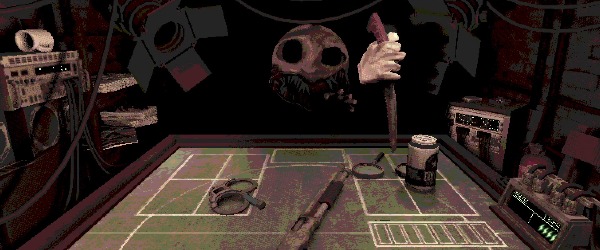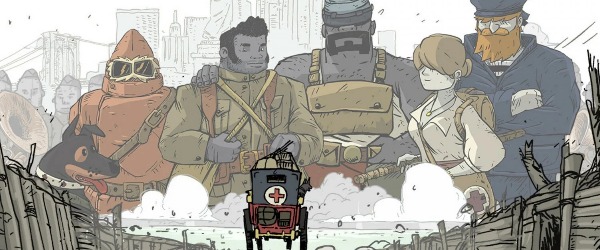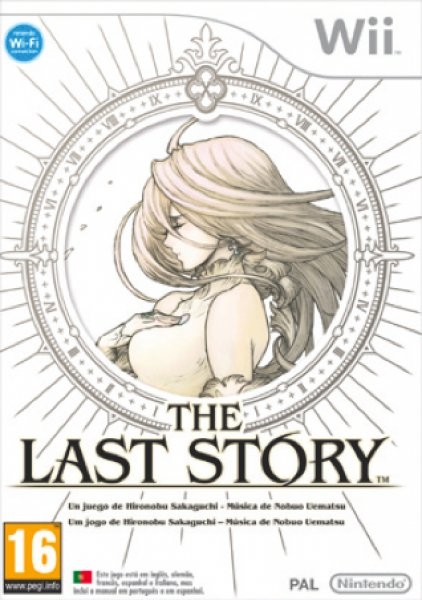
The Last Story - Review
by Karl Koebke , posted on 14 March 2012 / 8,417 ViewsWhen the three Wii JRPGs that later made up Operation Rainfall were originally announced, I thought The Last Story was a shoe-in to be the best of the three. Sakaguchi made one of the best JRPGs of this generation in Lost Odyssey and I thought The Last Story would repeat that success. Of course I then played Xenoblade Chronicles and found out just how high the bar had been set for the Operation Rainfall titles. Can Sakaguchi's first Wii effort live up to Monolith's incredible work?
The Last Story is about a band of mercenaries working for the count of Lazulis Island. Most of the time you play as Zael, who isn't the leader of the band but is soon bestowed with a strange new power from something called The Outsider. After clearing out some Reptids and recuperating at a tavern in town, you meet up with a girl named Lisa with whom Zael quickly falls in love. Of course things aren't so easy in JRPGs and it turns out Lisa's name is actually Calista, the daughter of the Count you work for, and she's already betrothed to another man. Add on an impending war with humanity's ancient foe The Gurak and you've got yourself a classic JRPG story.
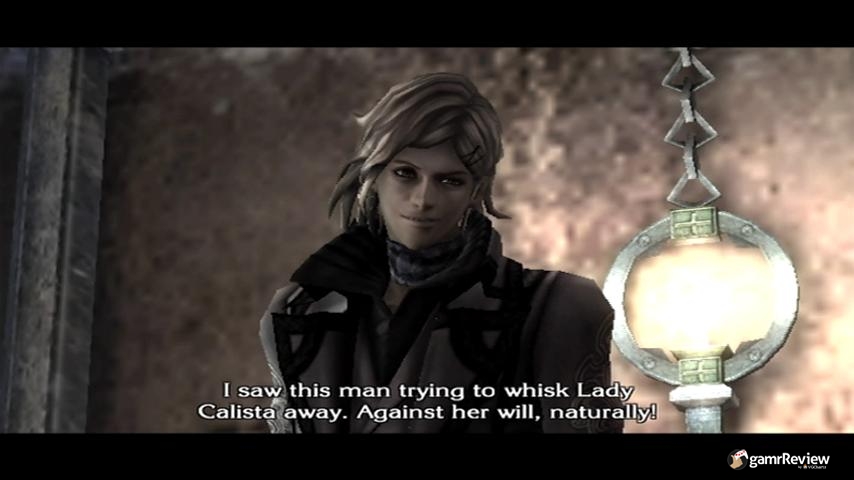
And this right here is her fiance, real class act this one.
Classic is really the perfect term for the narrative in The Last Story because throughout the entire thing I really didn't feel like there was much to propel it beyond what fans of the genre are used to. Your band of mercenaries is likeable enough and there are some interesting interactions with them, but the whole thing is over so quickly that I didn't get a feel for some of the characters at all. Only one other person in your group, outside of the main two characters, ever gets a really fleshed out back story, but at least the other members of your band are quick with the jokes so maybe you will care if they kick it. Realistically, though, by the third or fourth time the game makes you think someone is going to die and then fails to follow through it fails to have any impact the fifth or sixth time around. Things happen so quickly in The Last Story that I have a hard time caring about any individual event. It's as if the developers tried to smash the overarching storyline from a 60 hour JRPG into 18 hours. By the end of the game the island's castle has been destroyed and repaired so many times even the NPCs start to mention it. What you're left with is the JRPG equivalent of an action movie with good pacing and things constantly moving along, but the characters don't receive enough focus for you to form an attachment to them.
Action movies live and die on their fight scenes and shoot-outs, and for JRPGs that would have to be the battle system. The Last Story has a unique battle system, which is fast paced and makes for some interesting boss fights, but the controls can make some tasks more difficult than they otherwise should be. The first unique concept is that there is no attack button of any kind for Zael; if you get close enough to an enemy and move towards him you'll automatically start swinging like a mad man. If you're surrounded by baddies you can switch direction with your analog stick to take swipes at each one and keep the group at bay. The cover system was a key talking point prior to release, potentially bringing Mass Effect-like gameplay sensibilities to a JRPG for the first time, but in the end it's not nearly that meaningful. Since Zael is mostly a melee character whose crossbow doesn't do much damage, taking cover isn't used in a “stop and pop” style but instead it can be used as a brief respite when health is low. If you can get into cover close enough to your enemies you can then perform a slash move, which is helpful in a pinch, but it's not like Mass Effect where you're almost constantly acting from behind cover.
Much more meaningful than cover is the ability to give orders to your teammates. Each character only has two different skills that they can regularly use, but since you end up with a decent-sized group of four to six members in most battles, you actually end up with a reasonable amount of variety. Most of the time giving your group orders is a nice way to make them go against their norm and perhaps get a healer to throw out their damage spell, but sometimes it's necessary to tell everyone to retreat so that they'll all immediately spring to a central point (usually around a healer) and avoid a boss attack. Unfortunately, there is a cooldown on giving orders based on how quickly your skills bar resets and this can make some boss fights more annoying than they should be. So if you use the order to set your fire mage, Yurick, to use his most powerful spell, but directly after that the boss shoots up into the air for his most powerful attack, you'll be left unable to call out orders in time to save your group. Having a cooldown isn't a problem per se, but I don't see it as necessary for this particular battle system, and it's definitely a detriment for the more difficult boss fights.
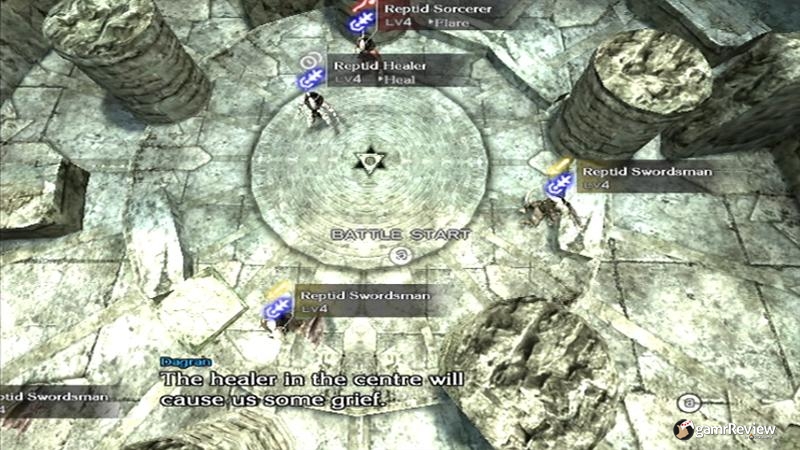
Nearly every battle starts with an overhead tactical view of the enemy.
Almost every spell that your casters can throw down comes with an aura on the ground near where the spell was cast. These auras give benefits if you run through them, such as giving you health over time or adding elemental damage to your weapon, but it's Zael's ability to disperse these auras that makes things truly interesting. Every friendly aura put down can be dispersed by Zael using Gale, which produces differing effects depending on the aura. Most of these effects are only useful against your garden variety monsters; making the enemy slip and fall repeatedly, for example, would be too powerful if it worked on bosses, but some are nonetheless absolutely essential for boss strategies. The final boss, in particular, will constantly put on debuffs like Death which will kill you after counting down from 30, but if you use Gale to disperse a healing aura you can not only give everyone in the group some much needed health but also remove any lingering adverse effects created by enemies.
The bosses in general are some of the most enjoyable parts of the game, because they would almost always require you to switch up your usual fighting style. Whether you're running away from an invulnerable boss until you've gotten the materials needed to do damage to them, or trying to position a boss below a giant sword so you can drop it down on him, it always shakes things up. There are some misses though, such as the boss fights that work against the game's own controls, like the mimic fight where you can attack your allies, which isn't ideal when attacking is the same as moving. Luckily, only a handful of the boss fights fall flat like this, but combine this with the finicky camera that sometimes refuses to do as you command and it makes for some infuriating experiences.
Another aspect that might make you think The Last Story is looking at the current WRPG landscape for ideas are the choices that you can make during the game, as well as a Mass Effect-style method of choosing between them. In battles this usually means that when you look at an obstacle with your crossbow that your mages can destroy you can tell them whether to do so or not. It helps add an extra element of strategy to the mix since some fights can be dealt with by taking out the ceiling or other parts of the environment instead of killing the enemies directly and it's quite often used for boss battles. In the storyline the choices are much less meaningful' you're either choosing whether or not to engage in a side quest, or making a fake meaningful choice that actually forces you to go the way the developers want anyway. There's little in JRPGs that irks me more than a story event with a fake choice thrown in.
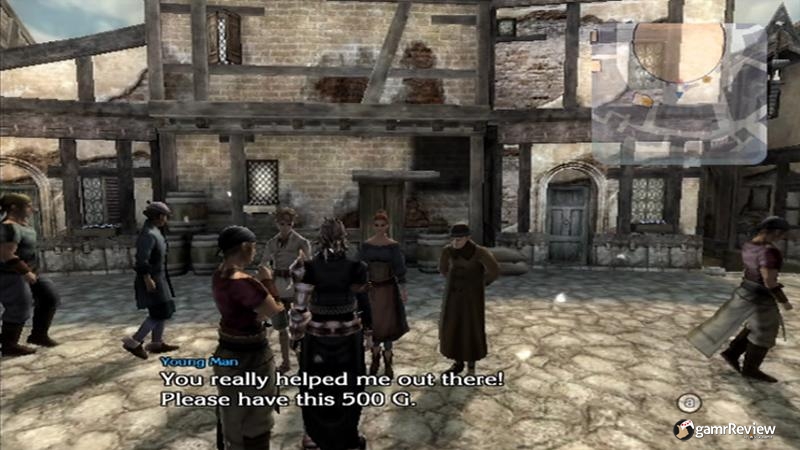
Get used to these buildings, you'll be seeing them a lot.
When you aren't duking it out with baddies, you'll probably be wandering around the game's one town. Those who didn't like how linear and constrained Final Fantasy XIII was should take note of this. While The Last Story does do better in that regard - by having at least one town that you can play around in - it is just a place to rest between extremely linear story missions or side quests, with little or no exploring to be had. You have been warned. One town is better than none though, and at least Lapulis Island is a fairly large town with a fair bit to do. Wander around a bit and you'll likely happen upon some items to pick up, such as materials that let you change the color of your crew's threads, and you can try your hand at playing the market. Buying low and selling high is actually an easy way of making some extra money, but it's kind of silly to think of working as a trader when you only have one place to sell items at any given time. Usually this means that trading just boils down to spending all of your extra cash on something you can sell (like almonds) and sitting on them until they go up in price based on the story.
Even with a decent amount of wandering and side quests completed in my playthrough, The Last Story only took me 18 hours to finish. After the main story is concluded you have a couple more side quests you can complete, which should add an extra hour or two to your play time, an arena in the city to play around in, a New Game+ feature, and, in a strange first for a JRPG, the active battle system even allows for competitive as well as cooperative online multiplayer. These additions are nice, but as a JRPG fan I value more time spent expanding the story and characters over extras like online multiplayer. The cooperative mode is fun and focuses on beating the game's bosses with up to five other people playing as different characters from the game, but since you only have to beat a single boss they're designed to be pretty short, and there isn't any online lobby or city that you can wander around such as the one in White Knight Chronicles. Overall it's not a great showing in value for the genre and neither the competitive or cooperative multiplayer is substantial enough to counteract the short playthrough time.
The environments in Xenoblade Chronicles really make it to one of the best JRPG experiences of this generation, but The Last Story is not so lucky in that regard. Characters have a nice style to them but the overall color palette is annoyingly muted, sometimes even to the detriment of the gameplay. Stepping into the city's arena, everything is so brown I honestly had a hard time telling what was going on at times. There are also noticeable issues with animations when things are moving from further away; movements from far off can look more like a slide show than a video game. It's not a poorly presented game by any means, it just doesn't do anything all that impressive. Like Xenoblade Chronicles, The Last Story has a British voice acting crew and they do their profession proud for the most part. There are a few emotional scenes that really seem like they weren't truly feeling what they were saying, but overall it's enjoyable.
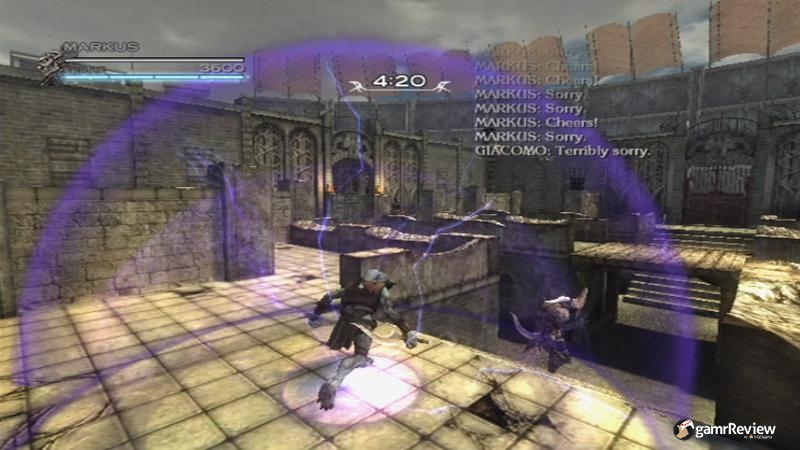
Online Competitive Multiplayer in a JRPG... a first for me.
So, in the end, I'm afraid I'd have to say that The Last Story does not live up to the bar set by its Operation Rainfall predecessor, but it's still a good time regardless. A fast-paced and usually fun battle system, and some interesting additions in the form of online multiplayer, are counteracted by an overly short main story and lackluster visuals. I hope Sakaguchi continues on, because if The Last Story is true to its name then it would be a comparatively disappointing end to his career.
This review is based on a retail copy of The Last Story for Nintendo Wii
update: The paragraph about giving commands was edited after I was told and double checked for myself that there was an indicator for the skill's cooldown. My apologies for not noticing this at the time.
VGChartz Verdict
7.6
Good








